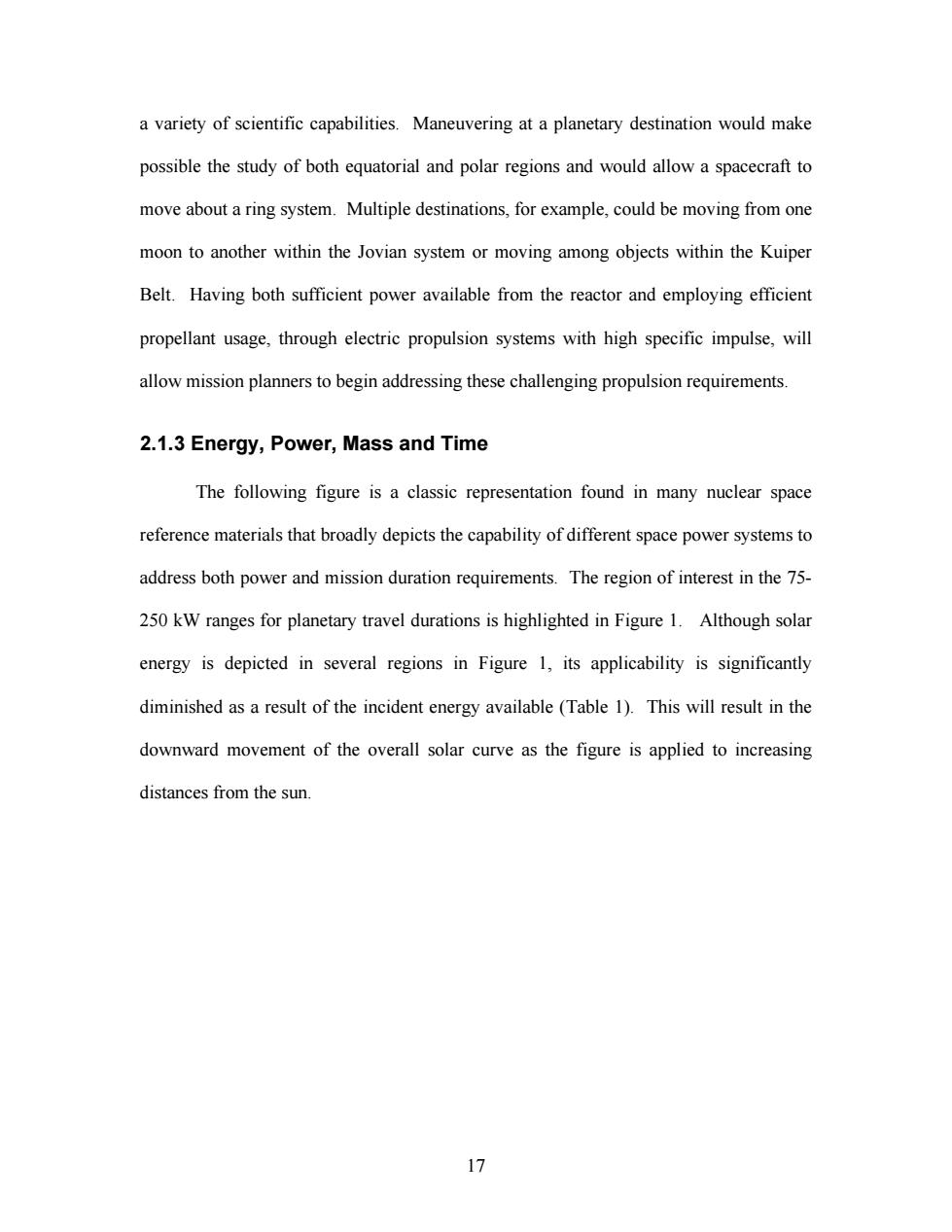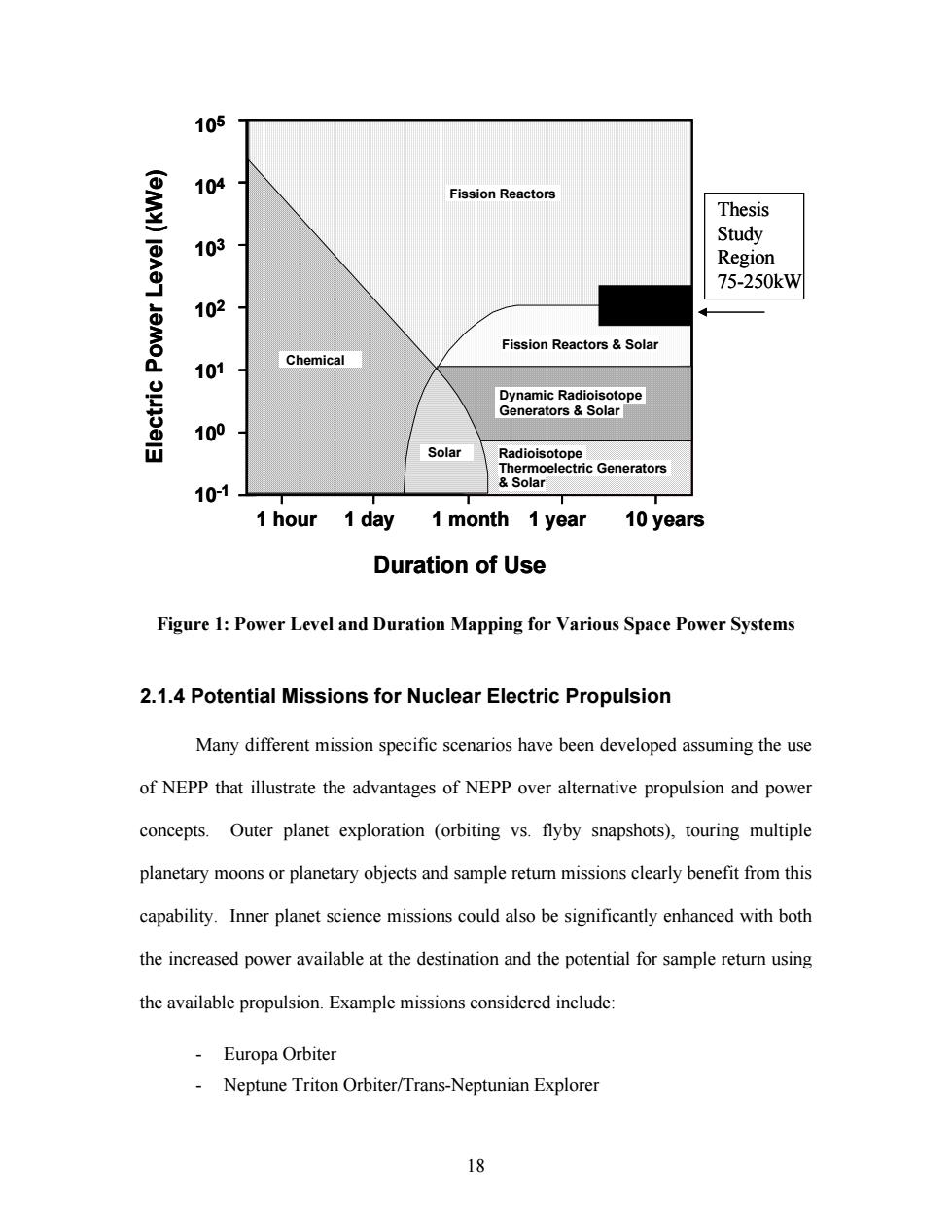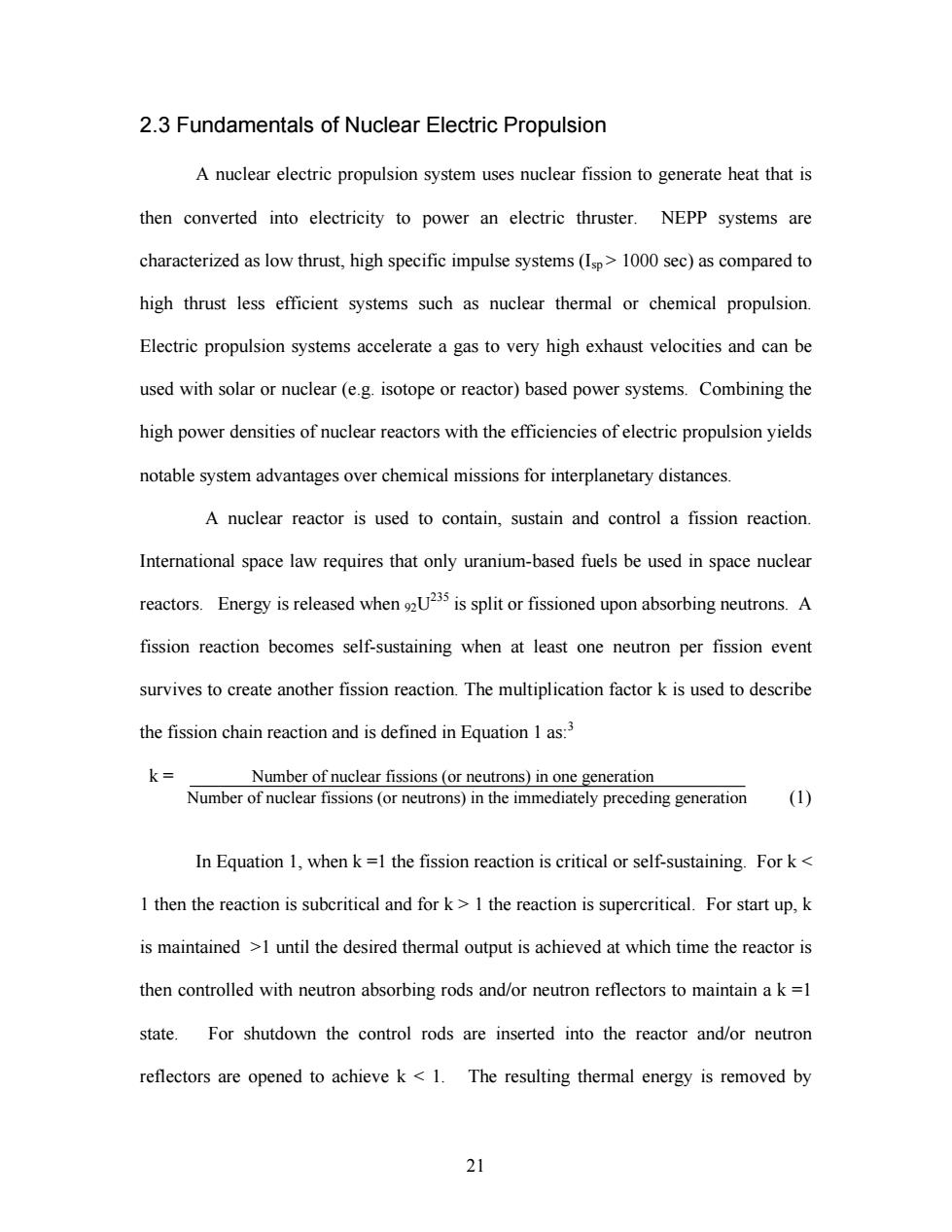
a variety of scientific capabilities.Maneuvering at a planetary destination would make possible the study of both equatorial and polar regions and would allow a spacecraft to move about a ring system.Multiple destinations,for example,could be moving from one moon to another within the Jovian system or moving among objects within the Kuiper Belt.Having both sufficient power available from the reactor and employing efficient propellant usage,through electric propulsion systems with high specific impulse,will allow mission planners to begin addressing these challenging propulsion requirements. 2.1.3 Energy,Power,Mass and Time The following figure is a classic representation found in many nuclear space reference materials that broadly depicts the capability of different space power systems to address both power and mission duration requirements.The region of interest in the 75- 250 kW ranges for planetary travel durations is highlighted in Figure 1.Although solar energy is depicted in several regions in Figure 1,its applicability is significantly diminished as a result of the incident energy available(Table 1).This will result in the downward movement of the overall solar curve as the figure is applied to increasing distances from the sun. 17
a variety of scientific capabilities. Maneuvering at a planetary destination would make possible the study of both equatorial and polar regions and would allow a spacecraft to move about a ring system. Multiple destinations, for example, could be moving from one moon to another within the Jovian system or moving among objects within the Kuiper Belt. Having both sufficient power available from the reactor and employing efficient propellant usage, through electric propulsion systems with high specific impulse, will allow mission planners to begin addressing these challenging propulsion requirements. 2.1.3 Energy, Power, Mass and Time The following figure is a classic representation found in many nuclear space reference materials that broadly depicts the capability of different space power systems to address both power and mission duration requirements. The region of interest in the 75- 250 kW ranges for planetary travel durations is highlighted in Figure 1. Although solar energy is depicted in several regions in Figure 1, its applicability is significantly diminished as a result of the incident energy available (Table 1). This will result in the downward movement of the overall solar curve as the figure is applied to increasing distances from the sun. 17

105 104 Fission Reactors Thesis 103 Study Region 75-250kW 102 Fission Reactors Solar 101 Chemical Dynamic Radioisotope Generators Solar 100 Solar Radioisotope Thermoelectric Generators 10-1 Solar 1 hour 1 day 1 month 1 year 10 years Duration of Use Figure 1:Power Level and Duration Mapping for Various Space Power Systems 2.1.4 Potential Missions for Nuclear Electric Propulsion Many different mission specific scenarios have been developed assuming the use of NEPP that illustrate the advantages of NEPP over alternative propulsion and power concepts.Outer planet exploration (orbiting vs.flyby snapshots),touring multiple planetary moons or planetary objects and sample return missions clearly benefit from this capability.Inner planet science missions could also be significantly enhanced with both the increased power available at the destination and the potential for sample return using the available propulsion.Example missions considered include: Europa Orbiter Neptune Triton Orbiter/Trans-Neptunian Explorer 18
10-1 100 101 102 103 104 105 Electric Po w er L e v el (kW e) 1 hour 1 day 1 month 1 year 10 years Chemical Fission Reactors Fission Reactors & Solar Dynamic Radioisotope Generators & Solar Solar Radioisotope Thermoelectric Generators & Solar Duration of Use Thesis Study Region 75-250kW 10-1 100 101 102 103 104 105 Electric Po w er L e v el (kW e) 1 hour 1 day 1 month 1 year 10 years Chemical Fission Reactors Fission Reactors & Solar Dynamic Radioisotope Generators & Solar Solar Radioisotope Thermoelectric Generators & Solar Duration of Use Thesis Study Region 75-250kW Figure 1: Power Level and Duration Mapping for Various Space Power Systems 2.1.4 Potential Missions for Nuclear Electric Propulsion Many different mission specific scenarios have been developed assuming the use of NEPP that illustrate the advantages of NEPP over alternative propulsion and power concepts. Outer planet exploration (orbiting vs. flyby snapshots), touring multiple planetary moons or planetary objects and sample return missions clearly benefit from this capability. Inner planet science missions could also be significantly enhanced with both the increased power available at the destination and the potential for sample return using the available propulsion. Example missions considered include: - Europa Orbiter - Neptune Triton Orbiter/Trans-Neptunian Explorer 18

Titan Explorer Multiple Kuiper Belt Objects Rendezvous Uranus Orbiter/Probe Jupiter Grand Tour of Moons Pluto/Charon Orbiter/Probe Mercury Sample Return Europa Sample Return Titan Sample Return Multiple Asteroid Sample Return Comet Nucleus Sample Return Trojan asteroids and Centaur minor planets High power Mars Orbiter Figure 2 provides approximate ranges of delta V,power level,and trip times associated with a few example NEPP missions.There are many factors such as planetary location,payload mass,launch vehicle capability and NEPP performance that will impact theses ranges.For comparison two example missions are provided that fall both below and above the thesis study range. 19
- Titan Explorer - Multiple Kuiper Belt Objects Rendezvous - Uranus Orbiter/Probe - Jupiter Grand Tour of Moons - Pluto/Charon Orbiter/Probe - Mercury Sample Return - Europa Sample Return - Titan Sample Return - Multiple Asteroid Sample Return - Comet Nucleus Sample Return - Trojan asteroids and Centaur minor planets - High power Mars Orbiter Figure 2 provides approximate ranges of delta V, power level, and trip times associated with a few example NEPP missions. There are many factors such as planetary location, payload mass, launch vehicle capability and NEPP performance that will impact theses ranges. For comparison two example missions are provided that fall both below and above the thesis study range. 19

~12+yrs. 100 90 80 4-6 70 -&-l0ys. ~8-11 yrs 60 ~4.5-55ys. -8-10 yrs. Power 50 -75-250kW 455.5y 40 9-11VIS 30 20 Chemical or Solar Electric Propulsion 10 0 Pluto Europa Pluto Jupiter Neptune Kuiper Belt Mercury Neptune Flyby Orbiter Orbiter Tour Orbiter Objects Sample Sample Return Return Figure 2:Example Missions,Delta V,Time and Power Approximations 2.2 Architectural Challenges NEPP systems are complex and can be considered highly multidisciplinary in nature.Disciplines range from the technical aspects of space nuclear reactors,power conversion,heat rejection,power electronics,electric propulsion and mission design to formidable safety,launch approval and political issues.It is essential that clear goals, functional domains,functions and architectural influences are identified before expanding and reducing the candidate sets.Identifying the most influential constituent components of the concept sets is a critical step to resolving the intricacies and interdependencies that drive the reduced sets and ultimately the final architecture.Concurrently,the process of simplifying the inherent complexity and ambiguity that exists in NEPP systems is paramount in satisfying technical,communicative,organizational and political objectives. 20
10 20 30 40 50 60 70 80 90 100 Delta V (km/sec) from L E O 0 Europa Orbiter Neptune Orbiter Pluto Flyby Pluto Orbiter Jupiter Tour Kuiper Belt Objects Mercury Sample Return Neptune Sample Return Power ~75-250 kW ~ 4.5-5.5 yrs. ~ 8-10 yrs. ~ 4.5-5.5 yrs. ~ 8-10 yrs. ~ 8-11 yrs. ~ 4 – 6 yrs. ~ 12+ yrs. Chemical or Solar Electric Propulsion ~ 9-11 yrs. 10 20 30 40 50 60 70 80 90 100 Delta V (km/sec) from L E O 0 Europa Orbiter Neptune Orbiter Pluto Flyby Pluto Orbiter Jupiter Tour Kuiper Belt Objects Mercury Sample Return Neptune Sample Return Power ~75-250 kW ~ 4.5-5.5 yrs. ~ 8-10 yrs. ~ 4.5-5.5 yrs. ~ 8-10 yrs. ~ 8-11 yrs. ~ 4 – 6 yrs. ~ 12+ yrs. Chemical or Solar Electric Propulsion ~ 9-11 yrs. Figure 2: Example Missions, Delta V, Time and Power Approximations 2.2 Architectural Challenges NEPP systems are complex and can be considered highly multidisciplinary in nature. Disciplines range from the technical aspects of space nuclear reactors, power conversion, heat rejection, power electronics, electric propulsion and mission design to formidable safety, launch approval and political issues. It is essential that clear goals, functional domains, functions and architectural influences are identified before expanding and reducing the candidate sets. Identifying the most influential constituent components of the concept sets is a critical step to resolving the intricacies and interdependencies that drive the reduced sets and ultimately the final architecture. Concurrently, the process of simplifying the inherent complexity and ambiguity that exists in NEPP systems is paramount in satisfying technical, communicative, organizational and political objectives. 20

2.3 Fundamentals of Nuclear Electric Propulsion A nuclear electric propulsion system uses nuclear fission to generate heat that is then converted into electricity to power an electric thruster.NEPP systems are characterized as low thrust,high specific impulse systems(Isp>1000 sec)as compared to high thrust less efficient systems such as nuclear thermal or chemical propulsion. Electric propulsion systems accelerate a gas to very high exhaust velocities and can be used with solar or nuclear(e.g.isotope or reactor)based power systems.Combining the high power densities of nuclear reactors with the efficiencies of electric propulsion yields notable system advantages over chemical missions for interplanetary distances. A nuclear reactor is used to contain,sustain and control a fission reaction. International space law requires that only uranium-based fuels be used in space nuclear reactors.Energy is released whenU235 is split or fissioned upon absorbing neutrons.A fission reaction becomes self-sustaining when at least one neutron per fission event survives to create another fission reaction.The multiplication factor k is used to describe the fission chain reaction and is defined in Equation 1 as:3 k= Number of nuclear fissions(or neutrons)in one generation Number of nuclear fissions(or neutrons)in the immediately preceding generation (1) In Equation 1,when k =1 the fission reaction is critical or self-sustaining.For k 1 then the reaction is subcritical and for k>I the reaction is supercritical.For start up,k is maintained >1 until the desired thermal output is achieved at which time the reactor is then controlled with neutron absorbing rods and/or neutron reflectors to maintain a k=1 state.For shutdown the control rods are inserted into the reactor and/or neutron reflectors are opened to achieve k 1.The resulting thermal energy is removed by 21
2.3 Fundamentals of Nuclear Electric Propulsion A nuclear electric propulsion system uses nuclear fission to generate heat that is then converted into electricity to power an electric thruster. NEPP systems are characterized as low thrust, high specific impulse systems (Isp > 1000 sec) as compared to high thrust less efficient systems such as nuclear thermal or chemical propulsion. Electric propulsion systems accelerate a gas to very high exhaust velocities and can be used with solar or nuclear (e.g. isotope or reactor) based power systems. Combining the high power densities of nuclear reactors with the efficiencies of electric propulsion yields notable system advantages over chemical missions for interplanetary distances. A nuclear reactor is used to contain, sustain and control a fission reaction. International space law requires that only uranium-based fuels be used in space nuclear reactors. Energy is released when 92U235 is split or fissioned upon absorbing neutrons. A fission reaction becomes self-sustaining when at least one neutron per fission event survives to create another fission reaction. The multiplication factor k is used to describe the fission chain reaction and is defined in Equation 1 as:3 k = Number of nuclear fissions (or neutrons) in one generation Number of nuclear fissions (or neutrons) in the immediately preceding generation (1) In Equation 1, when k =1 the fission reaction is critical or self-sustaining. For k < 1 then the reaction is subcritical and for k > 1 the reaction is supercritical. For start up, k is maintained >1 until the desired thermal output is achieved at which time the reactor is then controlled with neutron absorbing rods and/or neutron reflectors to maintain a k =1 state. For shutdown the control rods are inserted into the reactor and/or neutron reflectors are opened to achieve k < 1. The resulting thermal energy is removed by 21